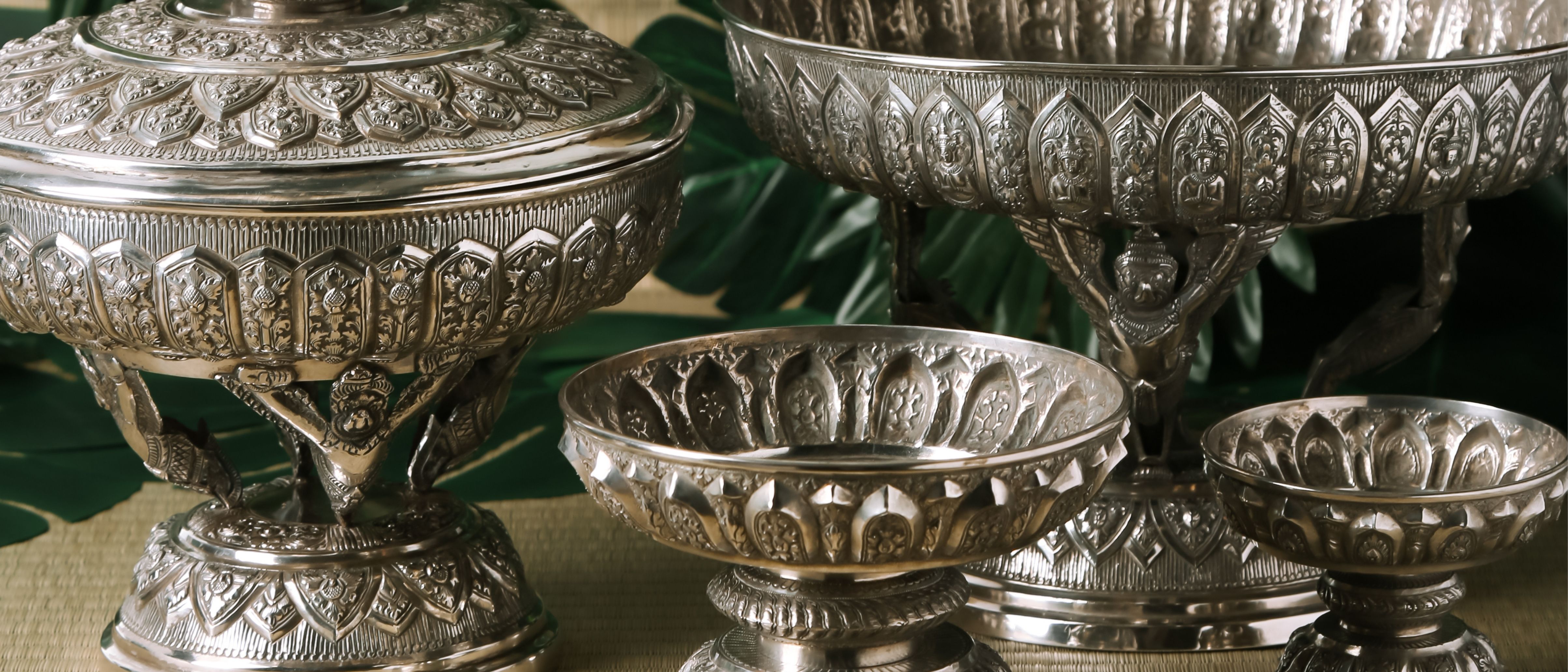

Cambodian silver of the mid-20th century is emerging as one of the most intriguing and increasingly sought-after areas in the silver market. Though still relatively under-researched in comparison to Thai silverware, it has begun to capture the attention of collectors and scholars alike.
The overlap between Cambodian and Thai silver has long caused confusion in the marketplace, with Cambodian pieces often mistakenly identified as Thai. While Thai silver has been the subject of more detailed scholarship, notably in Paul Bromberg’s Thai Silver and Nielloware (River Books, 2019), Cambodian silver remains largely undocumented beyond Vireak’s short publication Khmer Silverwares (Reyum Publishing, 2009).
At Chiswick Auctions, our Silver Department has seen growing interest in Cambodian silver, particularly from the 1940s to 1960s, with notable prices achieved for a variety of forms, including the tok, distinctive boxes, and ceremonial vessels.
A mid-20th century Cambodian silver covered dish on stand (Tok), circa 1940
Estimate £1,000-£1,500
The tok, or pedestal bowl, is perhaps the most recognisable form in Cambodian silver. Often covered, these vessels are richly chased with traditional motifs such as the lai dok phuttan (cotton rosemallow) or water lettuce patterns. Typically, the lid is topped with a tapering finial and conceals a removable inner liner, all fixed together with a central screw thread.
While these forms have ceremonial origins, many mid-20th century examples were clearly intended for the decorative market, often bearing French import control marks. Bases are frequently formed as Garuda, a significant figure in both Hindu and Buddhist cosmology. Sizes can vary greatly, from small 10 cm examples to those exceeding 28 cm.
A mid-20th century Cambodian unmarked silver covered bowl on stand (Tok), circa 1940-60
Sold for £812 incl. prem
A mid-20th century Cambodian unmarked silver dish on stand (Tok or Joeṅ Srāb), circa 1960
Sold for £1,250 incl. prem
Cambodian silver boxes come in a wide range of shapes and sizes, from large caskets to small figural forms. Rectangular boxes were often used for cigars or trinkets, while mangosteen-shaped containers with alternating decorative bands are particularly charming.
Animal boxes are especially appealing to collectors, often formed as stags, elephants, frogs or fish. Some examples display a Chinese influence, either in form or with inscriptions, and are thought to have been made by ethnic Chinese silversmiths operating in Cambodia.
A large and heavy mid-20th century Cambodian silver casket or cigarette box, presumably Phnom Penh circa 1950
Sold for £1,500 incl. prem
A mid-20th century Cambodian silver betel box formed as a recumbent stag, circa 1960
Sold for £688 incl. prem
A mid-20th century Cambodian or Thai silver betel box, circa 1950 marked Wen Liang
Sold for £1,125 incl. prem
Other vessels produced by Cambodian silversmiths include cocktail sets, vases, trays and water pots. These often display the same chased ornamentation seen in toks and boxes. Many are unmarked or bear numerical marks such as T90, T95 or T100 – referencing the tola, a unit of weight used in South and Southeast Asia. Some items were also stamped CAMBODIA or CAMBODGE in English or French, and a few bear French import marks such as the weevil (used between 1893 and 1984), which indicates a silver standard of at least 800.
A mid-20th century Cambodian silver cocktail set, presumably Phnom Penh circa 1950
Sold for £1,062 incl. prem
An early 20th century Cambodian unmarked silver kettle / water pot (Kar Nam Ton), circa 1920
Sold for £1,062 incl. prem
Some Cambodian-style items were made in Thailand, using techniques such as niello with silver gilt. An early 20th century lime box made in Bangkok or Nakon Sri Thammarat was created specifically for the Cambodian market and decorated with flame motifs.
A particularly exceptional piece is a late 19th or early 20th century silver casket chased with a depiction of The Churning of the Ocean of Milk, based on the celebrated Khmer bas-relief at Angkor Wat. Marked Bao Xing (a Chinese silversmith likely working in Bangkok), and bearing the French swan guarantee mark, the piece reflects Cambodia’s close historic ties with both Thailand and China.
An early 20th century Thai silver gilt niello lime box for the Cambodian market, Bangkok or Nakon Sri Thammarat circa 1930
Sold for £500 incl. prem
Cambodian silver is an exciting and evolving field of collecting. As research improves and interest continues to grow, these finely crafted objects are gaining recognition and value among collectors.
Get in touch with Head of Sivler & Objects of Vertu, John Rogers at john.rogers@chiswickauctions.co.uk or submit an Online Valuation.